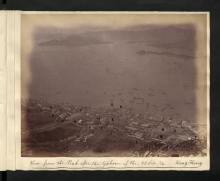Current condition
Demolished / No longer exists
Date completed
Date closed / demolished
(Day, Month, & Year are approximate.)
The site to the north of Queen's Road is the original site of the gas works.
It expanded to also occupy the site to the south of Queen's Road in the early 20th Century. In the comments below, Herostratus notes that a steel gasholder was completed on the southern site in 1910.



Comments
Gas Works explosion
Adam has noted there was a big explosion here on 14th May 1934. There's a summary of the event in point 13 of the Annual Report of the Police & Fire brigade:
13. Gas Works Explosion.—At 11.05 a.m. on the morning of 14th May, a large gasometer with a capacity of 500,000 cubic feet belonging to the Hong Kong and China Gas Company, Limited, at West Point exploded, the flaming gas setting light to houses in Clarence Terrace, Chun Sing Street and Yu On Terrace. Within two hours the fire was well under control although the work of searching the debris was not completed for another twenty-four hours. In all forty-two persons were killed or died from injuries received and a large number injured. Five houses were completely gutted and eleven damaged by fire and water. Apart from the actual gasometer which exploded, no damage was done to the Gas Works.
Steel Gasholder was completed
Steel Gasholder was completed on IL 834 in 1910
Source PWD report 1910 (No 36)
Dates
The Hong Kong Government Gazette from 17th October, 1874 reports damages after the typhoon of the 22nd and 23rd September, 1874.
Among these is: The majority of the lamp posts also lost their lanterns, and the gas works were so damaged that Gas could not be supplied to the Streets for two nights.
Source HKGRO
Aerial view on Shek Tong Tsui Gas Works
Gas works are marked on this aerial view from 1950.
This zone includes the two areas mentioned in the 1940 ordinance (see here):
(1) Whitty Street, between Des Voeux Road West and Queen’s Road West, comprising Marine Lots Nos. 190 and 191;
(2) between Queen’s Road West and Clarence Terrace, Inland Lot No. 834 Section A;
So originally the gas works were north of Queen's Road West, and expanded later to the area south of the road.
end of operation
On the 1957 map (HK Map Viewer), gas holders are shown on both places (north and south of Queen's Road West). On the area north of Qeen's Road West Wing Wah Mansions were built, first occupied 12/1962. So the the end of operation was about 1960.
Start of operation
From HONG KONG HONGS WITH LONG HISTORIES AND BRITISH CONNECTIONS by DAN WATERS*
On December 3rd 1864, Hong Kong was lit with gas for the first time.
The first manager in Hong Kong was R.C. Whitty. It was he who erected the plant, which came from Britain, on the waterfront at West Point (near Whitty Street). It was the first gas utility in the Far East. Jardine's office, the Hong Kong Dispensary (A.S. Watson and Company), and the Hong Kong Hotel were the first buildings to be lighted by gas.
Gas Works "Explosion" Report - A misunderstanding
On May 14 1934, the sudden collapse of a badly rusted steel gasometer caused a massive leak of coal gas into the air which then ignited. The heat from huge conflagration cause horrendous burns to those in the immediate vicinity and also set a residential building opposite to the site on fire, burning many people inside. All told, some 42 people died from their burns and other injuries and many more were seriously burned and scarred for life. The press ( an even government records) misreported this as a gas holder “explosion” but this was not actual case.
Professor C. A. MIDDLETON SMITH, M.Sc., M.I.Mech.E. (Taikoo Professor of Engineering in the University of Hongkong) writing in July , 1937 The Far Eastern Review in an article entitled “The Maintenance of Steel Structures in the Far East – Corrosion and Typhoons” explained :
“A Terrible Fire”
“There was a terrible conflagration of about 300,000 cubic feet of coal gas at West Point, Hong Kong Island. The rumours of an explosion inside the holder can be ignored …there was no explosion …300,000 cubic feet of gas simply burnt as a huge jet in the atmosphere which burnt itself out in seconds .” Professor Middleton went on to explain in his article that better corrosion inspection and prevention measures were required in the humid atmosphere of the Far East. .
Position of the marker
The marker should be moved north-west to the actual site.
re: Position of the marker
I've added notes and outlines for the two sites, and moved the marker from the south site to the older north site.
Thank you David, a perfect…
Thank you David, a perfect solution.